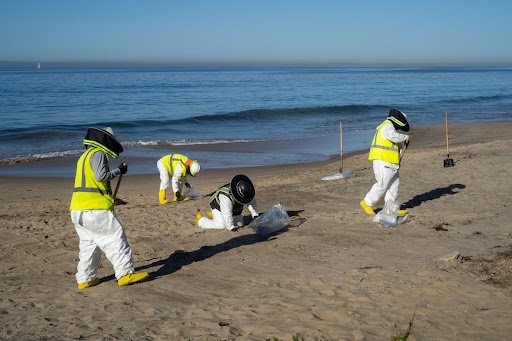Photo Series by Jemma Paradise
Surfers ride the waves at Huntington Beach, while cargo ships line up to enter the Long Beach Port along the horizon. The port has experienced an unprecedented vessel backlog, with a record 100 ships waiting to dock as of October 19th. Investigators suspect that one such cargo ship may have caused the oil spill when its anchor breached an offshore oil pipeline.
On October 1st, residents along the Pacific coast down in southern California sensed the faint smell of petroleum. An oil spill was confirmed the following day, 5 miles off the coast of Newport and Huntington Beach. According to Coast Guard Captain Rebecca Ore, "we have a high degree of confidence that the spill amount is approximately 588 barrels of crude oil". This environmental devastation equates to an estimated 144,000 gallons. Roughly a week later, the U.S. Coast Guard announced that the spill might have been smaller than previously thought, anywhere from 24,696 to 131,000 gallons.
A Common Dolphin glides through the waters off of Orange County, with an offshore oil drilling platform moored in the distance.
The California Department of Justice initiated an investigation to uncover the source of the leak, and officials have assembled a meeting to get to the bottom of the incident. The origin of the spill as well as the point in time it all started remains a mystery. Many authorities believe that anywhere from a year ago to the present day, an anchor scraped the pipeline within the ocean floor, fracturing the concrete casing. Other ships since then may have contributed to the original crack and escalated the leak’s environmental impact. Actors outside of ships have been evaluated as culprits, such as the water currents themselves. The bottom of the Pacific provides a lot of room for ambiguity.
Thousands of gallons of crude oil continuously seeping into Orange County’s coast have threatened the wellbeing of wildlife in the surrounding region. Thirteen miles of the coastline have been touched by the leaked fossil fuel. As Huntington Beach Mayor Pro Tem Kim Carr said, “this oil spill constitutes one of the most devastating situations that our community has dealt with in decades.”
The state Department of Fish and Wildlife temporarily closed fisheries in the area. So far, residents have witnessed a minimal impact on various species. As claimed by Orange County Supervisor Katrina Foley, dead birds and fish have washed up on the shore. Officials have advised avoiding recreational fishing and swimming until the water quality improves.
Beaches, wetlands, and animals just off the ocean shore are at the highest risk since it is more difficult to detect oil in the water. Seabirds especially are endangered for they are known to preen their feathers and ingest the oil, leading to hazardous “toxic exposure”, causing “direct damage to the gastrointestinal tract, evidenced by ulcers, diarrhea, and a decreased ability to absorb nutrients”. Some other products of this are hypothermia and neurological damage.
A Black-bellied Plover, photographed at Crystal Cove State Beach on October 15th. Across the beach, oil lines were visible along the water’s edge, where the plovers forage for food.
Many endangered avian species rely on wetlands, habitats that provide a place to refuel, stay safe, and engage with other animals within the biosphere. Oil within wetlands slows down the oxygen being transferred into root systems, potentially resulting in a loss of marsh area. The spill has now spread to Talbert Marsh, which plays a crucial role in filtering contaminants out of the water.
A hotline was created for residents in the case they ever encountered any marine life affected by oil. “Oiled birds” have been recovered from the spill area and taken to veterinarian care. It is also important to note that oil spills do not only harm animals, but also kill phytoplankton, a type of microscopic marine algae and a crucial component in freshwater and ocean ecosystems.
As one can see, the environmental impacts the Orange County oil spill has had are far and wide. The number one solution to prevent future oil spills is not to secure infrastructure or avoid anchor-pipeline collisions, it is to alleviate our dependence on fossil fuels as a whole.
The beach cleanup has been a communal effort on behalf of both volunteers and workers. Over 10,000 volunteers have stepped up to the plate to help out, a number that has fulfilled needs requested by the government. As of October 6th, 328 cleanup workers were hired, in addition to the already existing group of volunteers. In hope of raising funds, Huntington Beach officials have highlighted the Wetlands & Wildlife Care Center, which is “dedicated to the rehabilitation and release of injured and orphaned native wildlife”.
Cleanup workers from Patriot Environmental Services comb through the sand, in search of tar balls, at Crystal Cove State Beach on October 15th. As of that date, the hazard cleanup company, based in Long Beach, had deployed over 1,500 employees to O.C.’s beaches.
On October 11, Orange County officials reopened beaches after a water report clarified non-detectable petroleum compounds. Based on the most recent update from City of Huntington Beach, “the leak originated from a broken pipeline connected to Oil Platform Elly”, owned by Amplify Energy Corporation. The leak itself has stopped, although mitigation efforts are still underway.
Oil spills around the world have constantly instigated public alarm. We fear for our water quality, ecosystem health, the safety of our communities, and the wellbeing of wildlife. Occasional accidents are inevitable. The only way to confidently avert additional leakages of liquid petroleum into our oceans is to stray away from fossil fuels and move towards cleaner alternatives. Yet another reason to strive for renewable energy.




